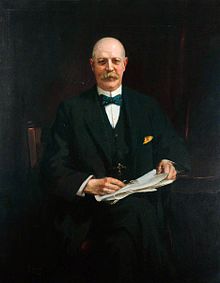
Summary
Charles John Bowen Cooke CBE (11 January 1859 – 18 October 1920) was born in Orton Longueville (then in Huntingdonshire) and was Chief Mechanical Engineer (CME) of the London and North Western Railway (LNWR).[2] He was the first to add superheating to the locomotives of the railway.[3] He wrote a book called British locomotives: their history, construction; and modern development which was published in 1893,[2] with a second edition in 1894, and third in 1899[4][1] A second book, Developments in Locomotive Practice followed in 1902.[2][5]
Charles John Bowen Cooke | |
|---|---|
 by James Peter Quinn (1869–1951) | |
| Born | 11 January 1859 Orton Longueville, Huntingdonshire, England |
| Died | 18 October 1920 (aged 61) Falmouth, Cornwall,[1] England |
| Nationality | English |
| Citizenship | British |
| Occupation | Engineer |
| Engineering career | |
| Discipline | Locomotive engineer |
| Employer(s) | London and North Western Railway |
| Significant design | LNWR Claughton Class |
Whilst CME of the LNWR he was responsible for the introduction of several new locomotive designs, including the George the Fifth and Claughton classes.[2]
He was appointed a Commander of the Order of the British Empire in the 1918 New Year Honours for his efforts during the First World War.[6]
He died on 18 October 1920 and is buried in the churchyard at St Just in Roseland, Cornwall.[2]
Locomotive designs edit
References edit
- ^ a b "Bowen Cooke, Whale & Beames". Retrieved 1 February 2015.
- ^ a b c d e Cooke, B.W.C., ed. (December 1963). "Notes and News: Bowen Cooke's grave". Railway Magazine. Vol. 110, no. 752. Westminster: Tothill Press. pp. 125–6.
- ^ "LNWR GeorgeV Locomotive Trust". Retrieved 7 April 2013.
- ^ "British locomotives: their history, construction; and modern development". Retrieved 7 April 2013.
- ^ "Development in locomotive practice Author: C J Bowen Cooke". Retrieved 7 April 2013.
- ^ "No. 30460". The London Gazette (Supplement). 7 January 1918. p. 368.
External links edit
- Bowen Cooke, Whale & Beames at steamindex.com


